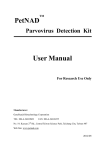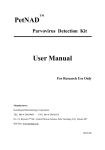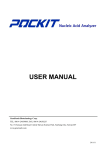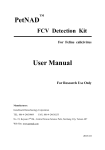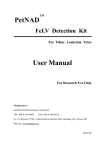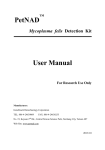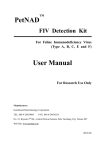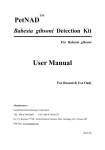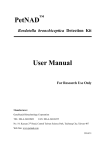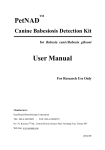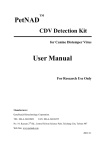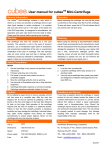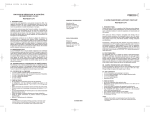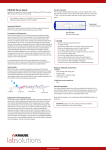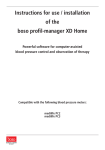Download Parvovirus Detection Kit User Manual
Transcript
TM PetNAD Parvovirus Detection Kit User Manual For Research Use Only Manufacturer: GeneReach Biotechnology Corporation TEL: 886-4-24639869 FAX: 886-4-24638255 nd No. 19, Keyuan 2 Rd., Central Taiwan Science Park, Taichung City, Taiwan 407 Web Site: www.petnad.com 2012/10 PetNADTM Parvovirus Detection Kit Content INTENDED USE ................................................................................ 1 SUMMARY AND EXPLANATION................................................. 1 PRINCIPLES OF THE PROCEDURE ............................................ 2 PRODUCT DESCRIPTION.............................................................. 3 A. Materials Provided .................................................................................3 B. Materials and Equipments Required, but Not Provided .........................3 C. Storage and Stability ..............................................................................4 D. Sample Type...........................................................................................4 PRECAUTIONS ................................................................................. 5 LIMITATIONS .................................................................................. 6 OPERATION PROCEDURE............................................................ 7 A. PetNADTM Parvovirus Detection Kit Quick Guide .......................... 7 B. Procedure ...............................................................................................8 DATA INTERPRETATION ........................................................... 10 ANALYTICAL SENSITIVITY ...................................................... 10 TROUBLESHOOTING ................................................................... 11 i PetNADTM Parvovirus Detection Kit REFERENCE ................................................................................... 14 ii PetNADTM Parvovirus Detection Kit INTENDED USE PetNADTM Parvovirus Detection Kit is intended for in vitro detection of parvovirus DNA based on the insulated isothermal polymerase chain reaction (iiPCR) technology. This kit is specially designed to be used with a compatible iiPCR instrument, POCKITTM Nucleic Acid Analyzer. The intended user of this kit is veterinarians or lab technicians who have basic laboratory skills. This kit is intended for research use. SUMMARY AND EXPLANATION Parvovirus is a highly contagious single-strand DNA virus. The virus is very stable in the environment, able to withstand wide pH ranges and high temperature. It is resistant to a number of common disinfectants and may survive for several months in contaminated areas. It can be especially severe in puppies that are not protected by maternal antibodies or vaccination. In the sever stage of infection, dogs can die within 48 to 72 hours if not treated with fluid or antibiotics. 1 PetNADTM Parvovirus Detection Kit Parvovirus detection by PCR is the most sensitive and specific method. However, conventional PCR takes three to four hours and requires delicate machines as well as well-trained technicians to perform the test. GeneReach has developed PetNADTM Parvovirus Detection Kit based on iiPCR technology, which significantly reduces the reaction time, and is as sensitive and specific as conventional PCR (Chang, H.-F. G., Tsai, Y.-L., Tsai, C.-F., Lin, C.-K., Lee. P.-Y, et al., 2012) for parvovirus detection. The assay has been simplified for easier and faster operation using compact equipments for parvovirus detection in the clinic. PRINCIPLES OF THE PROCEDURE The assay is based on iiPCR. In addition to specific primers, fluorogenic probe hydrolysis chemistry is used to generate a fluorescent signal when specific parvovirus DNA is presented in samples. The primers and probe target the gene specific to parvovirus sequences and will not react with canine and feline genomic DNA and nucleic acid of other pathogens. 2 PetNADTM Parvovirus Detection Kit PRODUCT DESCRIPTION A. Materials Provided (24 tests/kit) Component Premix Pack Contents or Purpose Amount Each pack contains 1 pack of 1 zip-lock bag desiccating agent and 1 Premix containing 24 vial with a lyophilized pellet individually sealed containing dNTPs, parvovirus packs specific primers, fluorescent probes, and enzyme. Premix Buffer B Reaction buffer to re-dissolve 700 μl/vial, 2 vials the lyophilized pellet P(+) Standard Dry plasmid pellet containing 1 vial parvovirus partial sequence Standard Buffer Reaction buffer to re-dissolve 110 μl/vial, 1 vial the parvovirus P(+) Standard R-tube 24 Pieces/bag, 1 bag Cap 24 Pieces/bag, 1 bag User Manual 1 B. Materials and Equipments Required, but Not Provided 1) PetNADTM Nucleic Acid Co-prep Kit 2) POCKITTM: the compatible instrument for PetNADTM 3) cubeeTM Mini-centrifuge (cubee) 4) Micropipette and tips 3 PetNADTM Parvovirus Detection Kit C. Storage and Stability 1) The kit should be stored at 4°C and is stable until the expiration date which is stated on the label. 2) Premix vials should be kept in the sealed Premix Pack to avoid the rehydration of lyophilized pellet. 3) Dissolved P(+) Standard can be stored at 4°C for up to 6 months. To avoid the degradation of P(+) Standard, it is recommended to aliquot the dissolved P(+) Standard into several vials. D. Sample Type This kit is suitable for detecting nucleic acid extracted from whole blood or rectal swab. 4 PetNADTM Parvovirus Detection Kit PRECAUTIONS A. Do not open the R-tube after the amplification reaction to prevent any carryover contamination. B. We strongly recommend that the working area for extraction procedure and amplification procedure should be separated into two independent spaces to avoid any possible contamination. C. Do not reuse the R-tube and Premix. D. The P(+) Standard is used to: 1) Confirm the operation procedure after installation, or when any uncertain result has occurred; 2) E. Ensure the kit performance after storage. In order to get optimal fluorescence detection, please wear powder free gloves Label area to handle the R-tube and do not mark and/or label the detection area of the R-tube. (The label area and detection area of the R-tube are indicated as shown) 5 Detection area PetNADTM Parvovirus Detection Kit LIMITATIONS A. The test should only be used for testing nucleic acid extracted from animal specimen. Do not add specimen (i.e. whole blood) directly into the Premix. B. PetNADTM Nucleic Acid Co-prep Kit is recommended for nucleic acid extraction. C. Any deviation from recommended procedure may not achieve the optimal results and should be validated by the users. D. Freshly prepared nucleic acid samples (within 1 hour after extraction) are strongly recommended to be used for PetNADTM Parvovirus Detection Kit to achieve optimal results. E. Vaccination with a modified-live parvovirus vaccine may result in positive PCR results for a few weeks after vaccination. Killed or vectored-recombinant vaccines will not interfere with PCR testing. PetNADTM is recommended in sick animals with clinical signs and/or laboratory abnormalities consistent with infection or in an animal with a suspected subclinical infection as based upon history, physical examination and clinical laboratory findings. 6 PetNADTM Parvovirus Detection Kit OPERATION PROCEDURE A. PetNADTM Parvovirus Detection Kit Quick Guide 7 PetNADTM Parvovirus Detection Kit B. Procedure Note: Please dissolve the P(+) Standard by 100 μl Standard Buffer at first time use. The dissolved P(+) Standard should be stored at 4°C 1) Open the Premix Pack according to the sample number and take out the Premix. Note: If the pellet is not at the bottom, please spin it down. 2) Open the cap, add 50 μl Premix Buffer B into each Premix tube. 3) Add 5 μl nucleic acid extract or dissolved P(+) standard into each Premix tube. Mix by pipetting up and down. 4) Transfer 50 μl of the Premix mixture into the R-tube. 5) Cap the R-tube, put into the holder of POCKITTM, and use cubee to spin down the solution. Note: Please make sure all solution has been spun down to the bottom of the R-tube. Perform the following amplification reaction within 1 hour to prevent nucleic acid degradation. Note: Please make sure there is no bubble in the tube. Please see the user manual of POCKITTM for details. 6) Turn on POCKITTM. The analyzer will complete self-testing within 5 minutes. Select 520 nm for use. “System READY” will be displayed. Note: Please see the user manual of POCKITTM for details. 8 PetNADTM Parvovirus Detection Kit 7) Place the holder containing the R-tube(s) into the reaction chamber of POCKITTM, and tap the cap of each R-tube to make sure the tube is properly positioned in the reaction chamber. 8) Close the lid and press “Run” to start the reaction program. 9) The test result will be shown on the screen after the reaction. 9 PetNADTM Parvovirus Detection Kit DATA INTERPRETATION Please check the results on the screen after the reaction. . * For example, from the screen, 520nm Interpretation Parvovirus Positive Parvovirus Negative Recheck with fresh sample. ANALYTICAL SENSITIVITY The detection limit of PetNADTM Parvovirus Detection Kit is up to 10 copies/ reaction. 10 PetNADTM Parvovirus Detection Kit TROUBLESHOOTING Observations Possible Causes Comment and Suggestions 1) The reuse of The micro-centrifuge tubes, tips, or Problems False Positive micro-centrifuge R-tubes and Premix are for one- tubes, tips, time use only. Reuse of these R-tubes and accessories will cause contamin- Premix. ation. Once used, the micro-centrifuge tubes, tips, R-tubes and Premix should be collected and discarded according to the local regulation. Do not place the waste close to the working area to prevent contamination. 2) Micropipette Disassemble pipette and do clean contaminated up. We recommend using aerosol free tips. Consult with GeneReach or local 3) Reagent contaminated distributor. Consult 4) Working area contaminated with GeneReach working area clean up. 11 for PetNADTM Parvovirus Detection Kit Observations Possible Causes Comment and Suggestions or Problems False Negative Check nucleic acid extraction 1) Nucleic acid extraction failed. 2) Bad nucleic acid quality or procedure. Please check the sample storage condition. concentration too Please refer to the Troubleshooting section of PetNADTM Nucleic Acid high Co-prep Kit. If a spectrophotometer is available, check OD 260/280 ratio. Normally, this ratio should be 1.4 to 2.0. Do not add too much nucleic acid. 3) PCR inhibition Please follow the operation procedure. Spike P(+) Standard for a parallel PCR reaction. If the one with P(+) Standard showed positive, then the inhibition was ruled out. If P(+) Standard was negative, then there was inhibition. prepare extraction. 12 another User need nucleic to acid PetNADTM Parvovirus Detection Kit Observations Possible Causes Comment and Suggestions or Problems Solution or other R-tube broken or interferences fall solution spilled in the into the reaction reaction chamber of chamber of POCKITTM POCKITTM 13 Consult with GeneReach or your local distributor. PetNADTM Parvovirus Detection Kit REFERENCE 1. Chang H.F. G., Tsai, Y.L., Tsai, C.F., Lin, C.K., Lee, P.Y., Teng, P.-H., Su, C. and Jeng, C.-C., (2012). A thermally baffled device for highly stabilized convective PCR. Biotech J 7: 662–666. 2. Parrish C.R.,(1995). Pathogenesis of feline panleukopenia virus and canine parvovirus. Baillieres Clin Haematol. 8:57-71. 3. Pollock R.V. and Coyne M.J.,(1993). Canine parvovirus. Vet Clin North Am Small Anim Pract. 23:555-568. 4. Tijssen P., (1999). Molecular and structural basis of the evolution of parvovirus tropism. Acta Vet Hung. 47:379-394. 5. Truyen U.,(1994). Canine parvovirus: recent knowledge of the origin and development of a viral pathogen. Tierarztl Prax. 22:579-584. 14

















